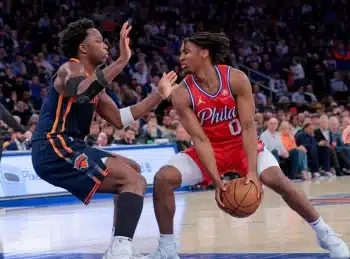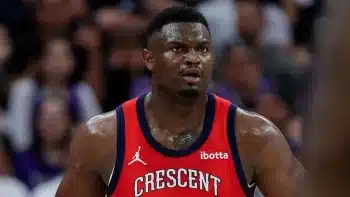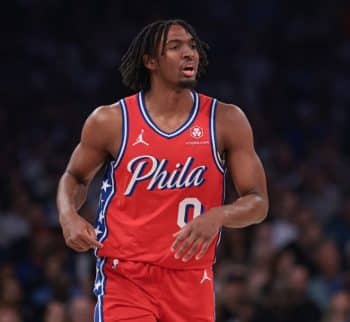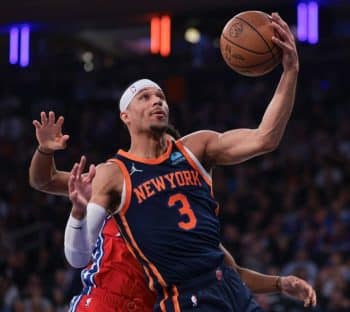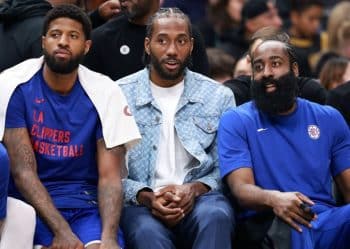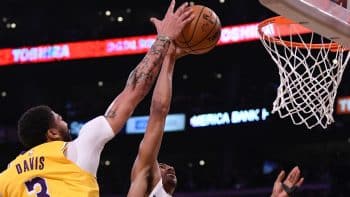NBA
Predictive or Predicament? Three Teams Poised for Regression

As with nearly every major team sport worldwide, win-loss record in the NBA can be an imperfect measure of true team quality. A simple yes/no result over 82 attempts lacks deeper context. It’s more than enough to separate the best from the worst in a 30-team league, but can be much less reliable for parsing teams grouped more closely together in the standings.
More importantly, through an offseason lens, raw wins and losses often fall well short in predictive power for future seasons. They don’t offer enough data points with which to accurately judge teams and players, and that’s before considering more obvious year-to-year factors like personnel movement and development, or decline from guys at various stages in their careers.
A few candidates for moderate to severe regression from their 2015-16 performances might surprise you. Note that “regression” here doesn’t necessarily mean playoff teams sliding to the high lottery – at least two of our top examples will still be in the postseason next April barring major catastrophe. There’s evidence to suggest each could take a step back overall, though, and perhaps a bigger one than surface factors would ever indicate.
San Antonio Spurs
There’s no danger of a playoff miss provided Kawhi Leonard stays healthy, but the usual ink we use to mark down the Spurs as elite title contenders might be better swapped with a dark pencil this year.
Personnel moves are the most obvious indicator, and allow us one final (okay, probably not final) ode to Tim Duncan here: He will be missed for more immediate reasons than legacy and culture. Duncan entered the league as one of its best defenders and left it the exact same way, with ESPN’s Defensive Real Plus-Minus ranking him as the second-most impactful per-possession defensive player in the NBA last season after controlling for team and opponent quality. Figures from Nylon Calculus continued to rate him among the league’s 10 best rim protectors even as he rarely ever left the ground to contest shots.
True to form, Duncan’s impact was felt on the floor even during plays he wasn’t directly involved in. The Spurs’ famous “anti-Moneyball” defense became markedly less so when he sat down: they allowed more attempts near the rim and a higher conversion percentage, and gave up nearly five more three-point attempts per-100-possessions, per NBAwowy.com. With Duncan out there, they were the NBA’s stingiest defense against the consensus “best” shots in the game.
San Antonio was still great defensively without Duncan so long as Leonard was on the floor, but dropped back to league average or even slightly below when both sat. Those minutes made up just over a quarter of the team total on the year, a figure that could nearly double this season if Kawhi’s minute load, already high for any recent Gregg Popovich player, remains similar. Neither LaMarcus Aldridge nor Pau Gasol has ever proven capable of approximating Duncan’s impact defensively.
There are concerns surrounding current roster players as well, namely fellow future Hall of Famer Tony Parker. Dragging around a 40,000-minute ball and chain that’s only further weighted by years of international play he’ll add to this summer in Rio, it’s worth wondering how much Parker has left in the tank. His jump shooting numbers have been exceedingly positive the last two seasons given his age and history here – so positive, in fact, that speculation as to their sustainability is justified. It’s tough to imagine a career 33 percent three-point shooter continuing to bang home over 40 percent from deep for much longer, and he won’t keep matching his career highs from longer midrange areas every year. It’s never fun to forecast a decline from such a crafty and likable player, but the smoke signals are there.
Does Manu Ginobili have another renaissance year in him, particularly gaudy jump-shooting numbers that blasted his career averages out of the water at 38 years old last year? Manu shot a ridiculous 54 percent on all midrange shots 16 feet and further from the hoop last season, per basketball-reference, nearly 20 points higher than his career mark.
Can Gasol fit alongside Aldridge on either end of the floor with both now over the age-30 threshold? David West and Boris Diaw were far from stars last year as both showed their age, but can San Antonio’s depth maintain with David Lee and Dewayne Dedmon in their place? Leonard is among the game’s best all-around players; is he really one of the five best shooters in the league, though, or simply a very good one, as the rest of his career before last season would indicate?
Look, these are the Spurs, and this is Gregg Popovich. They’d need guys playing on broken legs to miss 50 wins or the playoffs. They’re not winning 67 again, though, and it’s fair to wonder whether a more precipitous drop back into the West’s middle might be on the horizon.
Toronto Raptors
In theory, there’s nothing wrong with a two seed that reached Game 6 of the conference finals running it back the following year. In practice it’s all about the details, and a few are suspect north of the border.
First and simplest: Toronto’s two best players both had career years last season, and that sort of thing just doesn’t happen all that often. Kyle Lowry and DeMar DeRozan are both great-to-elite players at their positions, but at 30 and 26 respectively are unlikely to improve much. In fact, history – both personal and league-wide – suggests one or both could slide back a bit.
Lowry is a success story who blossomed from an overqualified backup into an All-Star in his late 20s, and he’ll deserve every cent of the mammoth deal he signs next summer after giving the Raptors three years of value that wildly exceeded his dollar figure. He’s also a guy with a history of running out of gas late in the season, and even the high-level peak he reached last winter feels a bit like fool’s gold.
Lowry topped his career high in three-point attempt rate last year; he can keep doing that pretty easily, but will his career-best success rate continue? It seems especially unlikely from the corners, where he shot nearly 50 percent on the year. Likewise with a free-throw rate that was steadily declining every season in Toronto before a sudden resurgence last year – like several elements of his game, it dropped off a cliff late in the season and into the playoffs. Undersized 30-year-old guards don’t often sustain this kind of single-season production when prior multi-year trends suggest they’re outliers, and Lowry’s style offers few distinguishing factors from these types.
DeRozan’s case is a bit murkier. He did post career bests in typically high-variance areas like jump-shooting, but the optimist sees a 26-year-old just entering his prime who can sustain those figures. His peripherals mostly remained solid or improved slightly.
But while this is less scientific, doesn’t it feel like the book is out on DeRozan after his first deep postseason run? His shooting and free-throw rate both dropped sharply against top defenders leaning on his weaknesses. Most teams don’t have Paul George and days to devote purely to scouting the Raptors, sure, but it’s not exactly tough for coaches to emphasize the sort of sell-out, under-every-pick approach that often turned him into a non-factor in April and May. The playoffs can be a harbinger of things to come in future years – even if DeRozan himself maintains last year’s value in a vacuum, the way he’s defended could strain his production.
The Raptors were dead last in the NBA for percentage of baskets assisted last year, relying heavily on Lowry and DeRozan to work their magic, and it could spell trouble in River City if either takes a step back. They’ll hope for better health from Jonas Valanciunas and DeMarre Carroll, but injuries masked the fact that even once they returned, Toronto was a better team while both sat on the bench.
This is understandable for Carroll, who may have strained himself getting back in time for the stretch run, but it’s a more worrying trend for Valanciunas. Frankly, departed Bismack Biyombo was pretty clearly the more effective center within Toronto’s most used lineup combinations. Valanciunas is a highly skilled beast in the right situation; whether this is that situation is a valid question with DeRozan back on the books long term and limited touches to go around. Don’t be shocked to see the Raptors quietly gauge his trade market on a fair contract if they underachieve.
It’s all a bit concerning for a team that already exceeded their Pythagorean expectation (based on point differential) by three wins, then added precisely zero new talent in the offseason. Biyombo’s departure hurts, especially on defense, where the Raptors would have been a bottom-half team during the minutes he sat. Patrick Patterson and Corey Joseph are nice players who have nonetheless probably reached their value ceilings. Dwane Casey has proven capable of connecting with and motivating his team, but he is also relatively incapable of adjusting his approach when better teams clamp down on Lowry and DeRozan.
Like San Antonio, the Raptors are at least one major injury away from being in any danger of finishing outside the playoff picture. Most simply penciling them in for a home playoff series could be in for a surprise, though, especially if moves from a few of their chief rivals behind Cleveland in the East pan out.
Portland Trail Blazers
Forecasting the Blazers after a pleasantly surprising 2015-16 comes down mostly to this: Do you believe the team that beat Golden State and Oklahoma City on the way to the league’s best record from mid-January through the end of February is the real thing, or is it the sub-.500 group we saw the rest of the year?
Sustainability isn’t an issue for Portland’s star guards, with Damian Lillard and C.J. McCollum both following traditional developmental paths and both young enough to expect continuation. Like the guard duo in Toronto, though, smarter teams poked holes in their shooting-driven style as the year went on last season, forcing the supporting cast into larger roles in which they mostly succeeded – and that’s where issues of continuity rear their heads.
Al-Farouq Aminu was a career 29 percent three-point shooter heading into last season; he nearly matched his attempts from those previous five years combined, and still managed 36 percent. Gerald Henderson likewise posted career highs in attempts and percentage from deep (he’s now in Philadelphia). Mason Plumlee hadn’t averaged even a single assist per night in his first two seasons until defenses began blitzing Lillard and McCollum up high last year, forcing the ball into Plumlee’s hands and tripling his output (it nearly doubled again from there in the playoffs as the Clippers and Warriors trapped even more aggressively).
These were non-trivial factors in Portland’s seventh-ranked offense, a unit that conveniently masked a bottom-10 defense. The Blazers did nothing in the offseason to dissuade teams continuing to aggressively hedge their pick-and-rolls; can the supplementary guys, now featuring Evan Turner, ostensibly in Henderson’s place, continue performing?
With the right tinkering from Terry Stotts, it’s certainly possible. Turner is a non-threat from three, but could be smartly staggered with Allen Crabbe to inject a bit more spacing if things tighten up – he’s a solid bench prop-up piece when Lillard or McCollum (or both) sit. Meyers Leonard is around as a spacing option, though he’s been a weakness on the other end. Noah Vonleh is running out of time to prove himself, and it feels like one of Vonleh or Maurice Harkless could become redundant and fall out of the rotation (or be traded). If Lillard and McCollum maintain their level and at least a couple of these guys shine, maybe there isn’t much cause for concern.
Even for glass-half-full types, though, big issues remain on the other end of the court. Portland picked up Festus Ezeli on a below-market deal, but getting a good price isn’t always the same as getting a good player. A return to the promise of a year ago could put Ezeli on track as a defensive anchor, but the 770 minutes he logged in Golden State last year (in an elite defensive culture, no less) offered little convincing proof that he can get back there.
Outside that, it’s tough to see where this group finds organic improvement defensively. Aminu is a wonderful universal jack, Crabbe is solid on the wing and Harkless did his best last year, but this team is devoid of much other defensive talent, especially in the backcourt. There’s only so much Aminu can do to cover for McCollum and especially Lillard, and slotting Crabbe onto tougher guards either opens up a mismatch with a bigger small forward or forces one of the studs to the bench. Rim protection will be a big issue if Ezeli isn’t the answer. It’s basically impossible to post even a league average defense with sieves on the perimeter and no one reliable to clean up inside.
None of this considers injury luck, either. The Blazers were among the league’s healthiest teams, particularly among their top guys – each of Lillard, McCollum, Crabbe, Aminu, Plumlee and Harkless played in at least 75 games, and Henderson logged 72.
Stotts is a proven wizard, and Lillard has made a habit of silencing doubters in his career. Still, it’s tough to shake the feeling that a bad break or two could doom a team that was four games from the ninth seed last year. The Blazers have to prove their streaky group can hit last winter’s level consistently.
